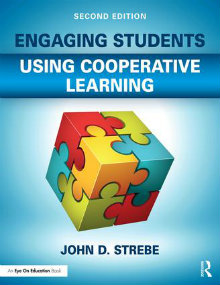Cooperative Learning the Way It Should Be
Engaging Students Using Cooperative Learning, 2nd Edition
By John D. Strebe
(Routledge/Eye On Education, 2018 – Learn more)

“Who reads a book on education when there are so many other attractive choices for spending our time? You are probably a person of passion, a person of three loves: a love for the subject you teach, a love for the students you inspire and a love for teaching” (p. XV).
It’s hard not to love a book that starts with such a joyful affirmation of teachers and professional development!

Cooperative learning can be defined in simple terms as students working together to learn. This second edition of Strebe’s book is filled to the brim with good advice, strategies, and lessons to help teachers use cooperative learning in their classrooms.
Setting students up for cooperative learning
In the first three chapters, Strebe starts with information on how to begin setting students up for cooperative learning on day one and into the first weeks. He emphasizes intentionally choosing student pairs and teams so that they are heterogenous and primed for productive interaction. He also reminds the reader to engage in team building activities before using cooperative learning with content. Strebe advises:
“I have concluded that three major errors are responsible for less than satisfactory results in the interaction classroom.
- Team size was inappropriate for the class.
- Team membership was not carefully, thoughtfully and purposefully decided.
- Team building was not adequately done” (p. 13).
To help avoid these pitfalls, there are explicit examples of how to group students successfully and how to build strong supportive teams.
Strategies to support student learning
Chapters 4, 5, and 6 are strategy based. The following cooperative learning structures are shared.
- Collaborative Worksheets: Students work together in pairs to learn information, ideas, or strategies presented on a worksheet. They use the RDC model. Respect: students have time to read through and think about the material provided independently and silently. Defense: Students work with their partner to defend and justify any conclusions they made about the content on the worksheet. Consensus: Paired students meet with another pair to come to consensus about the information on the worksheet.
- Collaborative Review/Tests: Several strategies are shared for helping students to practice and review learned content together. All involve independent work, students checking one another’s answers, and working together to strengthen learned skills.
- Interactive Lecture: Dispelling the myth that there is no room for lecture in a cooperative learning classroom, Strebe offers the think/pair/square/share strategy for managing interactive lectures. When the teacher asks a meaningful question, students think about it in four modes. Think allows for silent independent though, Pair offers students to chance to discuss thoughts with a partner, Square enlarges the the discussion to a group of four (two established pairs combined), and Share is when square teams offer the answer to the teacher or the entire class.
Big ideas and specific tools
The remaining chapters also offer strategies but are more big-picture focused. For example, Chapter 7 is called “Key Ideas.” Here the author focuses on “principles for creating and engaging classroom” (p. 84). These include building relationships, using diverse instructional methods, increasing accountability, and making excellent use of instructional time.
Chapters 8, 9, and 10 are practical and share information about grading, feedback, and team building. The last chapter is mostly question and answer and shares common concerns teachers have about cooperative learning along with Strebe’s helpful advice for overcoming them.
An enthusiastic invitation to practical solutions
Throughout the book, the author oozes his love for the profession, and his enthusiasm is contagious. He believes that, for many, teaching is less a job than a vocation. Stebe closes out the book with these thoughtful words, “My hope is that something in this book will enable the reader to better respond to the needs of students” (p. 141).
It did just that for me, and I think it would for most teachers. While there may not be any groundbreaking content, the strength of the book is that it offers practical solutions for teachers who want to better engage, allow for a collaborative culture, allow for student voice, and deepen student content knowledge.
Strebe writes, “It has been a privilege to teach and it is with gratitude that I share these ideas” (p. 141). Most readers of Engaging Students Using Cooperative Learning will feel a similar gratitude toward Strebe after reading this helpful text.
Rita Platt (@ritaplatt) is a National Board Certified teacher with master’s degrees in reading, library, and leadership. Her experience includes teaching learners in remote Alaskan villages, inner cities, and rural communities. She currently is a teacher-librarian, teaches graduate courses for the Professional Development Institute and writes for We Teach We Learn. She is also the author of MiddleWeb’s Heart of the School blog.






























